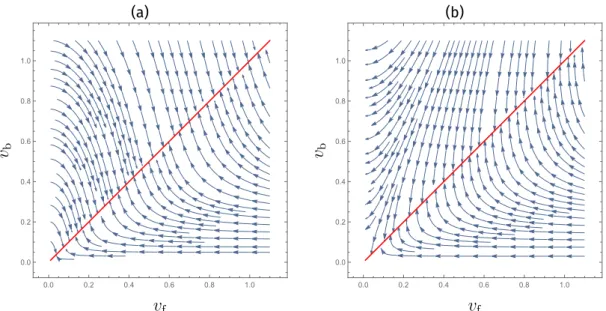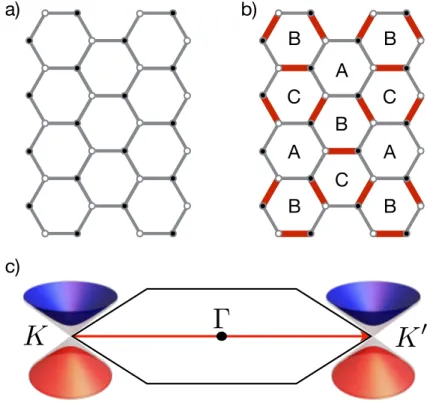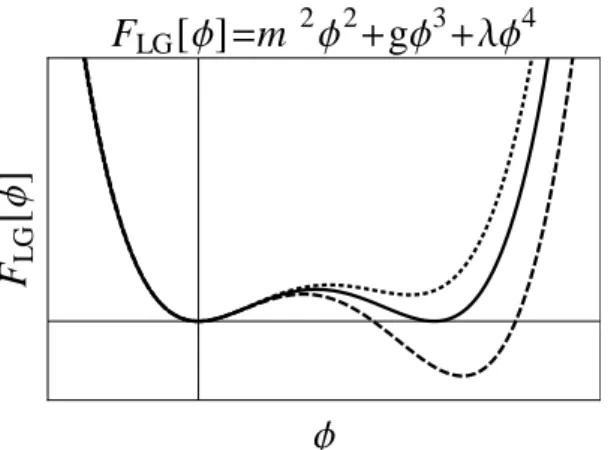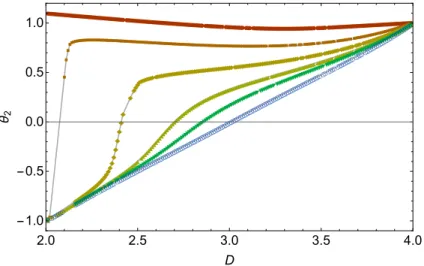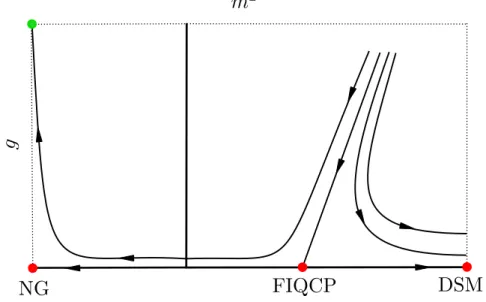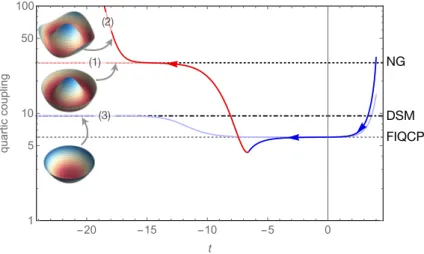Emergent symmetries in relativistic Quantum Phase Transitions
Inaugural-Dissertation zur
Erlangung des Doktorgrades
der Mathematisch-Naturwissenschaftlichen Fakultät der Universität zu Köln
vorgelegt von
Jesús Emilio Torres Ospina aus
Bogotá, Kolumbien
Köln, 2019
Berichterstatter: PD Dr. Michael Scherer Prof. Dr. Achim Rosch Tag der mündlichen Prüfung: 03.05.2019
iii
Abstract
This work deals with quantum phase transitions in Dirac systems where the symmetries involved play a key role in the nature of the transition and are enlarged at criticality. By using functional renormalization group (FRG) methods, we show that an emergent relativis- tic symmetry not present at the bare level is a common feature of several different kinds of phase transitions. In three different projects, the interplay of emergent symmetries and universality in critical phenomena are explored through FRG techniques. In the first project, we studied the relation between discrete symmetry breaking and the emergence of two di- verging length scales with their respective critical exponents. A second project explored the relation between multicritical points where two adjacent symmetry-breaking phases are compatible and the possibility of a continuous, order-to-order transition. The third and final project was concerned with the persistence of chiral symmetry in three-dimensional quantum electrodynamics - here seen as an effective description of different condensed matter systems - for the lowest possible number of fermion flavours, as well as with a dual description that has the potential to provide exact results for this strongly correlated theory.
Kurzzusammenfassung
Diese Arbeit befasst sich mit Quantenphasenübergängen in Dirac-Systemen, bei denen die auftretenden Symmetrien eine entscheidende Rolle für das kritische Verhalten am Über- gang spielen. Wir verwenden Funktionale Renormierungsgruppen Technicken (FRG) um zu zeigen, dass eine emergente relativistische Symmetrie ein gemeinsames Merkmal mehrerer verschiedener Arten von Phasenübergänge ist. In drei verschiedenen Projekten, wurde das Wechselspiel zwischen emergenten Symmetrien und Universalität durch FRG Technicken untersucht. Das erste Projekt befasste sich mit dem Zusammenhang zwischen diskreter Symmetriebrechung und dem Auftreten von zwei divergierenden Längenskalen sowie deren zugehörigen kritischen Exponenten. Im zweiten Projekt wurde die Verbindung zwischen multikritischen Punkten an denen zwei symmetriebrechende Phasen kompatibel sind und die Möglichkeit eines kontinuierlichen Ordnung-zu-Ordnung Übergangs beleuchtet. Das dritte und letzte Projekt befasste sich mit dem Bestehenbleiben chiraler Symmetrie in drei- dimensionaler Quantenelektrodynamik, die hier gesehen werden kann als eine effektive Beschreibung verschiedener Festkörpersysteme, für die niedrigst mögliche Anzahl von Fermio- nenarten als auch mit einer dualen Beschreibung, die das Potenzial hat exakte Ergebnisse für die stark korrelierte Theorie zu liefern.
v
Contents
1 Introduction 1
2 Phase transitions and relativistic invariance 7
2.1 Symmetry breaking and order parameters . . . . 7
2.1.1 Landau-Ginzburg-Wilson theory . . . . 9
2.2 Renormalization Group . . . 10
2.2.1 Critical behaviour from RG fixed points . . . 11
2.2.2 Functional Renormalization Group . . . 13
Truncations . . . 14
2.3 The case for Lorentz symmetry . . . 15
3 Emergent length scales from discrete symmetry breaking: the Kekulé Valence Bond Solid 23 3.1 Kekulé Valence Bond Solid on the honeycomb lattice . . . 24
3.1.1 Kekulé dimerization and related symmetries . . . 24
3.1.2 Fermion-induced quantum critical points . . . 26
3.1.3 Effective model for the Kekulé transition . . . 27
3.2 FRG analysis of the symmetry broken regime . . . 28
3.2.1 Truncation . . . 28
3.2.2 Flow equations . . . 29
Mass terms and bosonic potential . . . 29
Yukawa Coupling . . . 31
Anomalous dimensions . . . 31
3.2.3 Fixed point analysis . . . 32
Fermion-induced QCP belowD= 2 + 1 . . . 32
3.3 Flow from Dirac semimetal to Kekulé order . . . 33
Dirac semimetal regime. . . 34
Symmetry-broken regime . . . 35
3.3.1 Second correlation length exponent . . . 37
3.4 A sanity check: remark on the Potts model . . . 38
3.5 Conclusion . . . 40
4 Order-to-order transitions of Dirac fermions with compatible orders 41 4.1 Compatible orders in Dirac systems . . . 43
What could be missing in this picture? . . . 45
4.2 FRG analysis . . . 46
4.2.1 Fixed points and criticality from FRG . . . 47
4.2.2 Constructing the phase diagram . . . 47
DSM1+2phase . . . 51
vi
NGi⊕DSMj phases . . . 51
Order-to-order transitions withO(N)symmetry . . . 52
Phase diagram . . . 54
4.2.3 The caseN1=N2= 1 . . . 54
4.3 Conclusion . . . 55
5 Conformal symmetry of QED3atNF= 1and its dual description 57 5.1 Conformal scaling and its breakdown for QED3at lowNf . . . 58
5.1.1 Fierz-complete action . . . 59
5.1.2 β-functions . . . 59
5.1.3 Interacting conformal fixed point forNf> Nf,c . . . 61
5.1.4 Breakdown criterion of conformal scaling atNf,c. . . 61
5.2 QED3withNF= 1. . . 62
5.2.1 Interacting conformal fixed point . . . 64
5.2.2 Discussion . . . 64
5.3 Fermionic particle-vortex duality: an application . . . 65
5.3.1 The general idea and the bosonic version . . . 65
Bosonic particle-vortex duality in2d . . . 66
5.3.2 The fermionic duality . . . 68
Constraining the topological current correlator . . . 68
Scaling dimension of mass operator at one-loop . . . 70
5.4 Conclusion . . . 72
6 Summary and outlook 75 A Threshold functions 77 A.1 Threshold functions - Kekulé Valence Bond Solid . . . 77
A.2 Threshold functions for compatible orders . . . 78
A.2.1 FRG equations . . . 78
Masses and bosonic potential . . . 78
Yukawa couplings . . . 79
Anomalous dimensions . . . 80
A.3 Threshold function for the gauge field anomalous dimension . . . 81
B Direct derivations ofβ-functions of four-fermi couplings 83 B.1 Derivation ofβ-function∂tλfor four-fermi couplingλ . . . 83
B.2 Cancellation ofλ2term from flavor trace in∂tλ . . . 85
Bibliography 87
1
Chapter 1
Introduction
Understanding phase transitions and the critical phenomena associated to them has been a major driving force in the quest for unveiling which states of matter Nature allows and one part of fundamental physics that seems to continue to provide fruitful insights into the inner workings of our universe. The technological prowess of the last few decades has, moreover, allowed us to experiment with phenomena that were before, perhaps, thought to be only of academical interest, for they were not readily available in Nature. A prime example of this sort of development was the production in 2004 of a free standing two dimensional structure made of carbon atoms: graphene [1]. In fact, twenty years earlier, the first suggestions of an emergent relativistic low energy behaviour in graphite sheets had already been made [2, 3] and with these, the first attempts at understanding the possible phases in the system and the transitions between them.
Amongst the first interesting phenomena to be explored theoretically was that of breaking of chiral symmetry in graphene, and its related anomaly [3]. Chiral symmetry breaking is, however, a feature of strongly interacting systems (like QCD4), and graphene’s realization of a three dimensional Dirac fermion is known for being very good at screening the elec- tromagnetic interaction (at charge neutrality), due to the vanishing of the density of states at the Dirac point [4]. Lucky for us, the condensed matter setting allows several different interactions to be induced. These can mimic the action of a gauge field [5–7] and indeed, chiral symmetry breaking in Dirac systems can be achieved in different ways [8, 9].
One way to induce chiral symmetry breaking in graphene is by including adsorbed atoms on its surface [10–12]. In this case, the mass generation for the massless fermions is con- comitant with a Kekulé distortion, and the system goes into one of three equivalent ground states, each of which can be rightly called a Kekulé Valence Bond (KVB) configuration. The first experimental realization of this phenomenon [13] was achieved with graphene grown on a copper substrate, where the long range order was observed through scanning tunneling microscopy (STM) (see FIG 1.1). Once an experimental observation of the phase is achieved, it seems only natural to consider the phenomena related to the transitionintothis phase.
In fact, although some of the features of the system when it is in a KVB phase had been pro- posed [10–12] and partially confirmed experimentally [13], there had been considerably less effort in understanding the transition itself and the universality (or lack thereof) associated to it.
The nature of the underlying lattice and the particular ordering formed in this case are unique to the condensed matter setting (when compared to e.g. the high-energy-inspired,
2 Chapter 1. Introduction
Figure 1.1:Observation of Kekulé Valence Bondpatches on graphene grown on a copper substrate, as seen through STM. Figure adapted from [13].
emergent-gauge-field treatment), and play an important role for critical behaviour. Because these aspects had remained largely unexplored until recently [14–16], we set out to fill in some of the knowledge gaps in this area. In particular, we explored in detail questions like the nature of the transition (can it be considered as a first or second order transition? if the latter holds, under what conditions?) and features of the scaling behaviour of observ- ables when the system transitions from one phase to the other. The results of this analysis comprises Chapter 3 of this work.
The critical point describing a transition into the KVB phase of graphene is only one example of what has been dubbed in the literature as a Fermion Induced Quantum Critical Point (FIQCP) [17]. As such, not only are similar symmetry breaking patterns in other Dirac systems possible, but different realizations of the kind of mass generation described here could also appear simultaneously. By this we mean that a similar mechanism as the one described above could be responsible for twodifferentkinds of long range order in thesamesystem.
With this setting in mind, it becomes important to consider different ordering tendencies and how they interact with each other.
In the simplest setting, where the gapless, semimetallic Dirac phase could be adjacent to two gapped phases, the system exhibits a multicritical point (MCP) where all three phases meet. According to a Landau-Ginzburg description of the phase transition [18], when two adjacent phases have unrelated, independent symmetry properties, the transition between them is no longer generically1of second order (continuous), but is either of first order (dis- continuous) or accompanied by an intermediate phase, as depicted in FIG. 1.2. One of the key features of FIQCPs is that a simple Landau-Ginzburg description in terms of order parame- tersonlyneed not hold in a system where the low energy degrees of freedom are itinerant fermions, so the natural question arises as to whether or not these are the two only options.
Recent Quantum Monte Carlo (QMC) simulations [19] suggest that, indeed, a third option could be realized in Dirac systems: agenericdirect, continuous, order-to-order transition.
The findings in [19] moreover seem to indicate that the line separating the two phases (with brokenO(3)andZ2 symmetry, respectively) has an emergentO(4)symmetry (see Fig. 4.1 in Chapter 4). A quick search through the literature points to another system where such a
1By this we mean, without the need to do some extra fine tuning in the parameters driving the transitions.
Chapter 1. Introduction 3
g1 g1
g2 g2
D
O1 O1
O2
O2 D
M
Figure 1.2:Possible phase diagramscenarios in the vicinity of a multicritical point (MCP) according to Landau-Ginzburg theory. A disordered phase (D) can reach the ordered phaseO1/2 by tuning the parameterg1/2, and these two phases meet at the MCP (the red dot). The boundary between ordered phases can be either a line of first order (discontinuous) transitions (left) or
a region of coexistence (M) where both orders are mixed (right).
non-Landau transition is possible, namely a Deconfined Quantum Critical Point (DQCP) in spin-12 antiferromagnets on a square lattice. In that case, the critical point separating the Néel ordered phase (which breaksO(3)symmetry) from the valence bond solid (VBS) phase (which breaks O(2) symmetry) is more aptly described by emergent degrees of freedom (spinons) which couple to an emergent gauge field and render the transition continuous, while being confined in both of the ordered phases [20–22].
According to the numerical evidence [23], the transition there also shows an enlargedO(5) symmetry at the critical point. Furthermore, recent developments in numerical simulations of similar models indicate that emergent O(N) symmetries are an ubiquitous feature of DQCPs [24, 25]. One question that naturally arises is: could the emergent enlarged symmetry be a smoking gun signature for the kind of non-Landau transitions seen at DQCPs, namely, for the existence of a line of continuous order-to-order quantum phase transitions?
The first theoretical analysis of the kind of transition studied numerically in [19] confirmed [26, 27] that there is always2 an MCP with emergent O(N1 +N2) symmetry, if the adja- cent phases break independent O(N1)andO(N2)symmetries, respectively. These works served as inspiration to explore the phase diagram of Dirac systems with two compati- ble, dynamically-generated masses that come about through the same mechanism as the chirality-breaking KVB phase. The results in Chapter 4 summarize our partial understanding of the phase diagram of the system.
As mentioned earlier, graphene’s massless Dirac fermions can acquire a mass by the fluc- tuations from induced interactions, but its "natural" electromagnetic interactions are not strong enough to gap the system. This can be understood as a consequence of the fact that the system is only quasirelativistic, i.e. the velocity of fermions and of gauge degrees of free- dom is not the same and the electromagnetic interactions are still allowed to propagate in 3+1 dimensions, while the emergent massless fermions are confined to move in 2+1 dimen- sions. In fact, the fully relativistic theory analogous to the one in graphene corresponds
2Terms and conditions apply. These can be found in Chapter 4.
4 Chapter 1. Introduction
Figure 1.3: Expected phase diagram of QED3 as a function of number of flavours Nf, taken from [28]. Note that here Nf refers to 4-component
fermions, of which the minimal number allowed isNf = 1.
to three dimensional quantum electrodynamics (QED3) and is expected to exhibit sponta- neous chiral symmetry breaking below a critical number of fermion flavoursNf< Nf,c∼4.5, as depicted in FIG. 1.3 (see e.g. [28] and references therein). Note that the low energy theory of a single sheet of graphene corresponds to a system withNf = 2flavours of fermions.
To probe spontaneous chiral symmetry breaking in a2 + 1dimensional Dirac system, it thus seems, we need a way to have a truly three dimensional gauge field mediated interaction.
Nature3, as luck may have it, has found a way to provide this to us in the form of an effective theory for thesurface statesof an interacting 3+1 dimensional topological insulator (TI) [29, 30]. This latter realization, however, differs in one key aspect from the usual setting where e.g. FIG 1.3 is believed to hold: where as in high energy conventions relativistic fermions are collected in four dimensional representations of the Clifford algebra of Rd,1, their TI counterparts are made up oftwo-component fermions and, incidentally, onlyoneof them.
This situation can be loosely referred to as "Nf= 1/2".
Because the field theory at hand (QED3atNf= 1/2) seems to also be an effective description of several condensed matter systems [31–33], it seems natural to ask: can we also expect spontaneous chiral symmetry breaking in this setting? Our attempts to provide an answer to this question are collected in the first part of Chapter 5.
The relation of QED3 to one particular system, namely the half filled Landau level [33], is particularly interesting in our current setting since it more or less takes us back to square one but with "less" fermions. Concretely, it has been proposed [33–35] that the seemingly strongly interacting QED3shares the same low energy properties of (one quarter of) the free Dirac theory we started with4. We provide a simplified explanation of this equivalence as well as our attempt to extract universal information from it in the second part of Chapter 5.
Outline of the Thesis
The contents of this work have already been outlined in the above paragraphs and in ex- actly the order they appear in the thesis, with one small but important exception. Since
3Or theoretical physicists, depending on the point of view.
4Recall that the ground state of a normal graphene sheet can be described by an effective theory withNf = 2 flavours of free Dirac fermions.
Chapter 1. Introduction 5 the quantum phase transitions considered in Chapters 3 and 4 can be induced by diverse mechanisms, it is not at all clear from the outset that the degrees of freedom involved (i.e. the bosonic order parameters) have a low energy description in terms of relativistic dynamics. In the theoretical models used in those chapters, however, we do start from a Lorentz invariant Ansatz for the effective actions involved in which bosonic and fermionic degrees of freedom have the same velocity,vf = vb = 1(in approppriate units). The jus- tification for this choice is found in the final part of Chapter 2, right after a short recap on critical phenomena meant to set up notations and conventions and a recap of the variant of renormalization group tool used in all other chapters. Concluding remarks are gathered in Chapter 6. Appendix A contains detailed formulas used in the main text, and appendix B is a supplement to Chapter 5 and contains an alternative way to compute one of the main equations in that chapter.
7
Chapter 2
Phase transitions and relativistic invariance
In this chapter we discuss some of the common features that will be found in all of the prob- lems dealt with in later chapters. In Sec. 2.1 we introduce the common language we will use to describe phase transitions, starting with a recap of widely known facts. The discussion here therefore borrows heavily from standard textbooks (e.g. [36, 37]) and is by no means exten- sive since it serves mainly as a way to introduce the formalism that will be applied later on.
In Sec. 2.2.2 we describe our weapon of choice to tackle quantum phase transitions involving strongly interacting fermionic systems, namely the functional renormalization group. Again, the discussion is kept brief and the reader is advised to consult the literature for a more in depth treatment [38, 39]. Finally, Sec. 2.3 presents a first application of the formalism: a nonperturbative argument for emergent Lorentz symmetry at criticality in Dirac systems in d= 2spatial dimensions. The contents of section 2.3 are original, unpublished work by the author and are a crucial part of the setup in later chapters.
2.1 Symmetry breaking and order parameters
A quantum system whose ground state does not have the full symmetries of the hamiltonian describing it is said to exhibit spontaneous symmetry breaking [37]. Just as in thermal phase transitions, the onset of spontaneous symmetry breaking in quantum many-body systems is accompanied by the nonanalytic behaviour of some observable quantity [36]. Let the symmetry transformations of the system be denoted byG. If the ground state|Ψiis not invariant under the action of a symmetry elementg ∈G, then one can find an operatorO transforming nontrivially undergand such that
φ=hOi 6= 0, (2.1)
wherehOi:=hΨ|O|Ψiis the expectation value on the ground state. The quantityφwill be called an order parameter for the symmetryg. If the hamiltonian depends on a dimension- less parameter˜gsuch that the ground state is symmetric (φ= 0) for values ofg >˜ g˜cbut has broken symmetry (φ6= 0) for˜g <g˜cthen the phase transition at˜g= ˜gcis signaled precisely by the nonanalytic behaviour ofφ.
Order parameters thus serve as labels to identify different phases and are therefore key to understand the phase transitions between them. Consequently, they will be the main
8 Chapter 2. Phase transitions and relativistic invariance focus of a considerable part of this work and it will prove useful to get an intuitive feel for them. To this end, we consider a fermionic system whose time evolution is determined by the second quantised microscopic hamiltonian
H =H0+V , (2.2)
whereH0is the free part andV a two body interaction, i.e.
H0=X
α
αc†αcα (2.3a)
V =X
αi
Vα1,α2,α3,α4c†α1c†α2cα4cα3, (2.3b) withαa multi-index collecting all degrees of freedom including e.g. band and/or sublattice indices andc†α is an operator that creates a fermion in stateα. For spinful fermions on a simple lattice, for example,α= (~k, s), with~k ∈U ⊂Rd is a momentum vector in the first Brillouin zoneU ands∈ {±1}denotes the spin projection on thezaxis in units of~/2.
Order parameters of interest for such a system can be defined as expectation values of bilinears of the original fermions, namely, combinations of the form
Oα,β =X
δ,γ
Veα,βδ,γc(δ†)c(†)γ , (2.4)
where the coefficientsVeα,βδ,γ can be thought of as a partial decomposition of the kernel of the interacting potentialV. To illustrate this last point, consider a translation invariant system of spin1/2fermions, for which the bare interactionV isSU(2)conserving, thenα= (~k, s) andVα1,α2,α3,α4can be split as
Vα1,α2,α3,α4 =U(~k1, ~k2, ~k3)(2π)dδ(~k1+~k2−~k3−~k4)S({~σi}). (2.5) where S is a function depending on the product of spin-rotation invariant combinations
~σi·~σj for i, j ∈ {1,· · ·,4}. An analytic functionS with these properties depends on the products of such combinations so that it can be further decomposed into parts commuting or anticommuting with the components of the spin operators. The coefficients of such a decomposition correspond to a choice ofVe and lead to the order parameters
ρ(~q) :=
*X
~k,s
c†s(~k+~q)cs(~k) +
, (2.6a)
M~(~q) :=
*X
~k,s,s0
c†s(~k+~q)(~σ)s,s0cs(~k) +
, (2.6b)
i.e., to order parameters for staggered charge density or staggered spin magnetization [40, 41]. It is worth pointing out that also order parameters of the form∼c†c† (e.g. accounting for the formation of Cooper pairs) can be written in the aforementioned form. Alternatively, one can consider order parameters starting from a given fermion bilinear and considering the kind of interactions that could give rise to nonvanishing expectation values for it. This approach, in turn, provides a way to identify the kind of interaction that leads to a breaking
2.1. Symmetry breaking and order parameters 9 of the symmetry.
First hint of universality and field theory description When the phase transition is such thatφ= 0atg˜= ˜gcthe transition is said to be continuous or of second order. Close to˜gc, the correlation lengthξassociated to the observableO, defined as the exponent in
hO(x)O(0)i ∼e−|x|/ξ, (2.7)
diverges as a power law, that is
ξ−1∼ |˜g−˜gc|ν , (2.8)
for ν a positive number. Because of this divergence, all other intrinsic length and en- ergy scales in the system play no role and the onset of nonzero φ depends only on the general features of the system, like the dimensionality and the symmetry properties that O breaks/preserves. A description of the transition is thus possible in terms of a coarse grained theory for the order parameter - a continuous field - since changes at microscopic scales become irrelevant (in the nontechnical sense) and one can expect only these univer- sal aspects to be of importance.
2.1.1 Landau-Ginzburg-Wilson theory
Let us start by considering a thermal phase transition in spatial dimensionD, where the parameter that needs to be tuned to reach said transition is temperature (i.e. g˜ = T). A good starting point to understand the vicinity of the critical point T = Tc, is to describe the dynamics of the space dependent order parameterϕ(x), wherex∈RD, by the Landau- Ginzburg free energyF[ϕ] =kBT S[ϕ], with
S[ϕ] = Z
dDxκ
2(∂iϕ)2+V(ϕ)
, (2.9)
whereV(ϕ)is an analytic function ofϕ, andi= 1,· · ·, D. In the action Eq. (2.9),κ, as well as the coefficients ofV in an expansion in powers ofϕ, contain all microscopic details of the system and can be thought of as phenomenological parameters that can, in principle, be determined from, e.g. experimental or numerical data. In the simplest scenario, where the only relevant symmetry isϕ → −ϕone can truncateV to the lowest nontrivial order, that is,
S[ϕ] = Z
dDxκ
2(∂iϕ)2+r 2ϕ2+ u
4!ϕ4
(2.10) wherer∼T−Tcchanges sign at the critical point. The inclusion of a spatially varying order parameter is an improvement on the mean field treatment (corresponding toκ = 0) and can be further improved by considering all possible field configurations in a path integral formalism. One thus setsF=−ln(Z), where
Z= Z
Dϕ exp(−S[ϕ]). (2.11)
is the partition function of the system.
10 Chapter 2. Phase transitions and relativistic invariance From the partition functionZin Eq. (2.11) one can now obtain then-point functions which provide information about e.g. the susceptibility and other observable quantities.
2.2 Renormalization Group
Renormalization group techniques combine the idea that the properties of a system depend on the energy scale at which it is probed with the scale invariance and universality implied by the divergence of the correlation length. Although the method has proven to be useful in a variety of contexts [42], we will be mainly interested in its use in describing critical phe- nomena and consequently our discussion of the method will go straight to this particular aspect.
The basic idea of the renormalization group transformation is to perform an iterative evalu- ation of the partition function Eq. (2.11) where in each step one integrates out or decimates certain degrees of freedom only, in such a way that at the end of the iteration process all degrees of freedom have been considered. In a lattice system of spins, for example, this could be adding the contributions of spins in a given block to define a new coarse grained spin variable [43].
The form of decimation we will be interested in consists of integrating out high energy de- grees of freedom and is closely related to the so called momentum-shell RG which we now describe. Consider a system whose energy is a monotonic increasing function of momen- tump:=|~p|, e.g. a quadratic in momentum dispersion, then one can distinguish between low and high energies by spliting momenta into "fast" and "slow" modes, i.e. Λ/b < p <Λ or0< p <Λ/b, respectively, whereb >1andΛis the UV cutoff of the theory (for a lattice, this would be the inverse lattice spacing). This induces a spliting of the field variables as ϕ=ϕ++ϕ−, whereϕ±only contains fast/slow Fourier components.
The effective actionSeff is now defined as exp(−Seff[ϕ−]) :=
Z Dϕ+ exp(−S[ϕ++ϕ−]), (2.12)
and by rescaling the fields and couplings, one can rewrite the latter so that it takes the same form of the bare action, thus producing a mapping in the set of couplings,
xi →x˜i(b,{xj}). (2.13)
If the procedure is performedntimes, the limitn→ ∞, corresponds to integrating out all degrees of freedom, so that the field independent part so obtained would correspond to the free energy density of the system. Considering the decimations by the factorb to be made up of infinitesimal steps of sizeδt, i.e.b'1 +δtforδt1, one obtains from Eq. (2.13) a system of differential equations of the form
d
dtxi=βi({xj(t)}), (2.14) and it is at this point that the divergence of the correlation length comes into play again.
Indeed, the procedure just described is nothing but a rescaling of the momentum scales of the system, and close to the phase transition, the fact that there is a divergent length scale
2.2. Renormalization Group 11 in the system leads to scale invariance. From this it follows that a stationary point of the differential rescaling transformation Eq. (2.14), i.e. the so called beta functions, describes the behaviour of the couplings at the phase transition.
For interacting field theories, however, obtaining an exact beta function is as complicated as solving the full theory so that this procedure is often impossible to carry out, and one must resort to approximations. Within perturbation theory, one thus identifies some control parameter and the approximation takes the form of a series of Feynman diagrams in said parameter.
Although it is beyond the scope of this work to describe in detail the methods devised for this purpose, it is worth mentioning two common approximation methods whose results often serve to compare the results obtained with the nonperturbative method that will be described in Section 2.2.2: The first one, the-expansion, uses the fact that the scaling of fields depends on the dimension of spacetimeD in such a way that there is a dimension Dusuch that forD > Duall couplings not present in the free theory get reduced with each successive RG step, and thus become unimportant. Low order expansions in terms of the difference := Du −Dshould thus provide trustworthy results close to ∼ 0. Unfortu- nately, the systems of interest to us are such that= 1, so that high order expansions are required to obtain sensible results and even then, the validity of the results in the limit→1 cannot be ensured without further independent checks and/or complicated resummation schemes. The second common method is applicable whenever there is a large numberNof some degrees of freedom of the theory (e.g. components of the order parameter or flavours of fermions), in which case a similar expansion can be performed in powers of1/N. This method suffers from the same disadvantage as the-expansion, namely that the systems of interest to us usually lie in the range ofN∼1, so that results obtained within a largeNex- pansion usually need to be complemented by other methods. Nevertheless, and as stated above, both methods serve as a valuable guide to benchmark some of the results obtained by nonperturbative methods where no obviously small control parameter is available and we will make use of this observation in chapters 3 and 5.
2.2.1 Critical behaviour from RG fixed points
In the vicinity of a continuous phase transition, the free energy density, and consequently several physical quantities of interest of the system, display scaling behaviour similar to that of the correlation lengthξin equation Eq. (2.8). The scaling properties of the different ob- servables like susceptibilites and other correlators of the theory should thus be accessible from information about the fixed point that describes said phase transition, as discussed in the previous section. We now describe how to extract this information from knowledge of the beta functions.
The set of beta functions for all the couplings of the theory are the prototypical example of a dynamical system [44], for which there are extensive results and analogies that can not only be carried over almost verbatim, but can also provide useful insights [45]. Of partic- ular interest for us is the stability analysis, i.e. the description of properties close to the stationary points of the flow.
12 Chapter 2. Phase transitions and relativistic invariance In the following, we rephrase the discussion in terms of the renormalization timet, which is defined as
t:= ln k
Λ
≤0, (2.15)
with Λthe UV cutoff of the theory. Denoting the full set of couplings by a vector as ~x, a stationary point is then just an element in coupling space~x∗such that
β~(~x∗) =~0, (2.16)
and for analytic beta functions we can linearize the system of equations Eq. (2.14) to study deviations from this point. Denoting these as~y :=~x−~x∗, the linearized system takes the form
d
dt~y=M~y , (2.17)
where
Mij := ∂βi
∂xj
~x=~x∗, (2.18)
is thestability matrixof the critical point. The solutions of equation Eq. (2.17) are given by
~y= exp(Mt)~y0, (2.19)
from where the following physical picture of the vicinity of the critical point in terms of the spectrum of−M- denoted byσ(−M)- emerges: all directions with positive eigenvalue correspond to couplings that are driven away from their critical values when the scale is changed, while those with negative eigenvalues correspond to couplings flowing towards their critical values. Directions in the kernel ofM correspond to couplings that freeze at different values depending on the initial conditions. Couplings satisfying these conditions will be calledrelevant, irrelevantandmarginal, respectively. Sinceσ(M)is in general com- plex, the previously introduced classification should be understood to apply to the real parts of the eigenvalues.
A continuous phase transition can now be identified with a stable saddle point, i.e. a station- ary point that has only one relevant direction. In this case, one can obtain the correlation length exponent,ν, from the scaling hypothesis and the assumption that close to criticality ξis the most important length scale. Concretely, if one denotes the momentum scale byk, and if the parameter corresponding to the relevant direction is denoted byg, the singular part of the free energy density scales as
fsing(g(k))∼ξ−(d+z)∼ |g−gc|(d+z)ν ∼k(d+z)/θ1 , (2.20) wherezis the dynamical exponent relating frequency and momentum asω∼kz, and
θ1:= max{σ(−M)}; (2.21)
2.2. Renormalization Group 13 is the largest eigenvalue1of the stability matrix.
Away from the critical point and in the disordered phase wherehϕi = 0, the correlations in the system will fall off asC(x)∼e−|x|/ξ, so the scaling behaviourexactlyat criticality is characterized by another exponent, namely the anomalous dimension of the order param- eter. The anomalous dimensionηmeasures the algebraic decay of the two point correlator of the order parameter,
G(x) :=hϕ(x)ϕ(0)i ∼ e−|x|/ξ
|x|d−2+η , (2.22)
and, together withν, they provide all scaling exponents of response functions of the system [39].
Saddle points with more than one relevant direction will be identified with a first order transition or with a multicritical point joining three or more different phases. In the latter case, and when the fixed point involves only two relevant directions, we say the multicritical point is stable.
2.2.2 Functional Renormalization Group
The renormalization group transformation described in the previous section can be imple- mented exactly in terms of a functional closely related to the generator of one particle irreducible diagrams,Γ, also known as the effective action. This is particularly useful, since n−point correlators depend solely on these diagrams. The effective action is obtained from the generating functional by adding a source termJ, as
exp(W[J]) :=
Z Dϕ exp(−S[ϕ] + Z
Jϕ), (2.23)
and then taking a Legendre transformation of this quantity, i.e.
Γ[φ] := sup
J
Z
Jφ−W[J]
. (2.24)
To implement the renormalization group on the effective action we construct a new scale dependent functional by introducing an infrared cutoff at the scalek, denoted byΓWk [φ], in such a way that at any given scalek, only fluctuations with momentaq2≥k2are included in ΓWk . In the limitk→0all fluctuations are included so thatΓW0 = Γis the full effective action.
At the UV cutoff scaleΛno fluctuations are included andΓWΛ =Sis the classical action. Such a functional interpolating between the full (effective) and bare actions can be constructed by following the same procedure used in contructingΓ, but with the replacementS→S+
∆Sk, where
∆Sk[ϕ] := 1 2
Z dDq
(2π)Dϕ(q)Rk(q)ϕ(−q), (2.25) andRk(q)is a regulator function that satisfies three properties:
1Note that we assumed, as is actually the case in spacetime dimensionD >2, that the space of non-irrelevant couplings is of finite dimension so that for all fixed points,σ(−M)is compact and can be ordered by ordering its real parts.
14 Chapter 2. Phase transitions and relativistic invariance (i) limk→0Rk(q) = 0for fixedq.
(ii) limk→∞Rk(q) =∞.
(iii) Rk(q)does not explicitly break any global symmetries inS.
With a regulator satisfying the above properties, the flow equation forΓWk , usually referred to as the Wetterich equation, is given by [42, 46]
∂tΓWk [Φ] = STr ∂tRk
ΓWk (2)+Rk
!
, (2.26)
where
ΓWk (2) =
−
→δ δΦΓWk
←−δ
δΦ , (2.27)
is the functional Hessian andSTrdenotes the super trace, i.e. a trace that includes a nega- tive sign for each fermionic component of the (column) vector of fieldsΦ. The notation here is merely used to distinguish the functional just defined from the effective action generating the one particle irreducible diagramsΓ. From now on we will drop the superscript and refer to this functional simply as the effective action.
For a given regulatorRk, properties of the flow are nonuniversal and scheme dependent at intermediate scales, but the conditions imposed on Rk ensure that they approach the scheme-independent and therefore physically relevant quantities of interest. For this rea- son, one has a lot of freedom in choosing the regulators. In particular, given that Eq. (2.26) has a one loop structure, one can choose a regulator that simplifies the required loop in- tegrals. A convenient choice in relativistic systems that we will often use is the linear opti- mized Litim regulator [47]. For bosons, it takes the form
Rk(q) =Zk(k2−q2)Θ(k2−q2), (2.28) whereZk :=k−η is the "wavefunction normalization" including the anomalous dimension η, andΘis the Heaviside step function. For fermions a similar regulator can be defined by including the spinor/band structure. These form of regulator has some convenient conver- gence properties while allowing analytic evaluation of the loop integrals involved in com- puting Eq. (2.26).
Truncations
The exact equation Eq. (2.26) is usually impossible to solve for nontrivial models and ap- proximation schemes have to be devised. These take the form of an infinite hierarchy of integro-differential equations that can be truncated to a given order to make them a closed system. The main approaches involve either a vertex or a derivative expansion, both of which we will now briefly describe.
The vertex expansion consists of, as the name suggests, expanding both sides of Eq. (2.26) in powers of the involved fields and matching the resulting coefficients. This kind of approxi- mation is particularly useful when extracting information about instabilities in condensed matter systems, for it gives an unbiased way to probe the momentum dependence of, e.g.
competing order parameters.
2.3. The case for Lorentz symmetry 15 Derivative expansions are particularly useful when the momentum dependence of inter- acting vertices is known beforehand and one is interested in long-wavelength physics, i.e.
where the order parameter fields can be expected to vary smoothly in spacetime. In this case, an expansion in gradients of the order parameter fields is sensible. To implement this approximation, an Ansatz forΓis made, which for anO(N)-symmetric theory takes the form
Γk= Z
dDxh1
2Zk(ρ)(∂µφα)2+Uk(ρ) +1
4Yk(ρ)(∂µρ)2+· · ·i
, (2.29)
with ρ := φ2α/2. When one further setsY = 0, and considers Z to be field independent this approximation is known as the improved local potential approximation, or LPA’. It is this approximation that we will use in the following chapters, where we further expand the potentialU(ρ)in a Taylor series around a running minimum, and truncate up to some power of the fieldφ.
Convergence and validity of results The FRG method does not rely on any parameter being small (like e.g.or1/N) and for any particular truncation there is, in principle, no clear cut method to control the range of validity of the results obtained. For the particular truncations described above, one way to check for the consistency of results is to include all symmetry allowed couplings (in LPA’) or vertices (in the vertex expansion) up to a given power of the fields, and neglect the flow of higher order terms.
In LPA’ the approximation of considering powers of the field up to orderNis aptly referred to as LPA’N. The reliability of the obtained results can thus be measured by the convergence of observable quantities when increasing the order of truncation. For this reason, in the next chapters we will always include all allowed couplings up to some N (high but, of course, finite) where it is already clear that the results for, e.g., critical exponents converge.
2.3 The case for Lorentz symmetry
As a first application of the formalism reviewed in Section 2.2.2, we provide a simple and fairly general argument for the emergence of Lorentz symmetry at criticality in certain phase transitions of interacting Dirac systems. Specifically we will argue that, at the critical point, the velocities of fermions and of bosons reach the same value and that the difference of velocities is an irrelevant parameter in the system.
Our starting assumption is that the bare action possesses relativisticcovariancein the sep- arate bosonic and fermionic sectors. This assumption, in turn, consists of two separate statements:
(i) All spatial directions are equivalent.
(ii) The (bare) dynamical exponent controlling the frequency momentum relationω∼kz, satisfiesz= 1.
To proceed, we consider a system of gapless Dirac fermions that interact with anNb-component order parameter field ϕ. The final assumption will be that the interaction is such that a~ nonvanishing expectation value for the order parameter corresponds to the opening of a
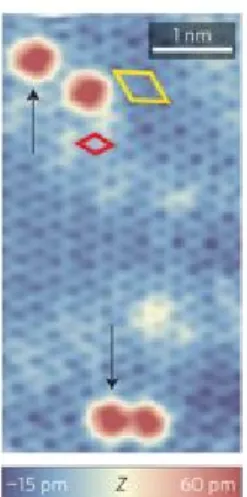
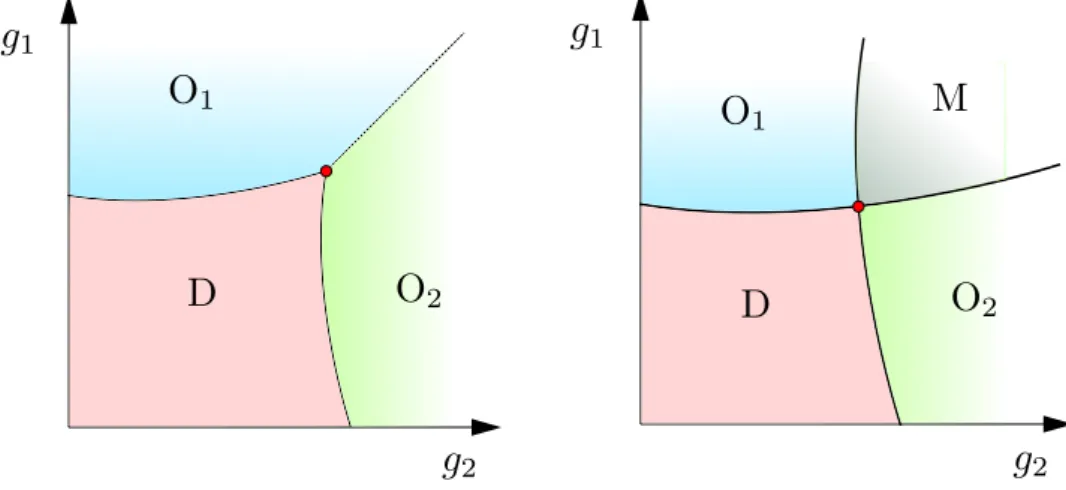
![Figure 1.3: Expected phase diagram of QED 3 as a function of number of flavours N f , taken from [28]](https://thumb-eu.123doks.com/thumbv2/1library_info/3703740.1506120/10.892.224.598.122.353/figure-expected-phase-diagram-function-number-flavours-taken.webp)
